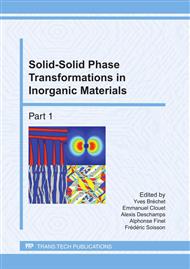p.735
p.741
p.747
p.753
p.760
p.766
p.772
p.778
p.784
Precipitation in a near Beta Titanium Alloy on Ageing: Influence of Heating Rate and Chemical Composition of the Beta-Metastable Phase
Abstract:
In the present study we focus on the precipitation processes during heating and ageing of β-metastable phase in the near β Ti-5553 alloy. Transformation processes have been studied using continuous high energy X-Ray Diffraction (XRD) and electrical resistivity for two different states of the β-metastable phase. Microstructures have been observed by electron microscopy. Different transformation sequences are highlighted depending on both heating rate and chemical composition of the β-metastable phase. At low temperatures and low heating rates, the hexagonal ωiso phase is first formed as generally mentioned in the literature. Increasing the temperature, XRD evidences the formation of an orthorhombic phase (α’’), which evolves toward the hexagonal pseudo compact α phase. For higher heating rates or for richer composition in β-stabilizing elements of the β-metastable phase, ω phase may not form and α’’ forms directly and again transforms into α phase. A direct transformation from β-metastable to a phase is observed for the highest heating rate. The formation of the metastable ωiso and α’’ phases clearly influences the final morphology of α.
Info:
Periodical:
Pages:
760-765
Citation:
Online since:
June 2011
Price:
Сopyright:
© 2011 Trans Tech Publications Ltd. All Rights Reserved
Share:
Citation:


